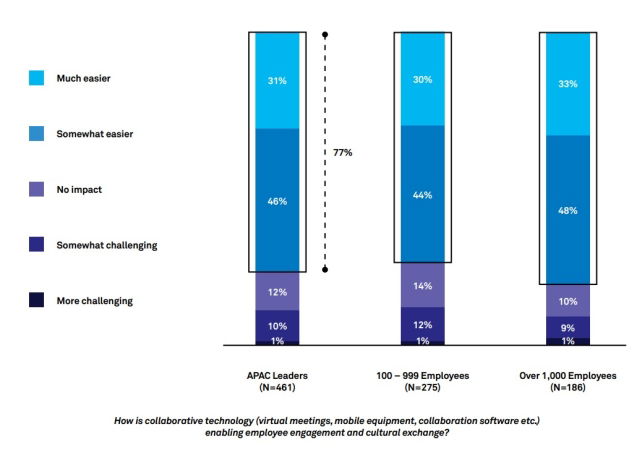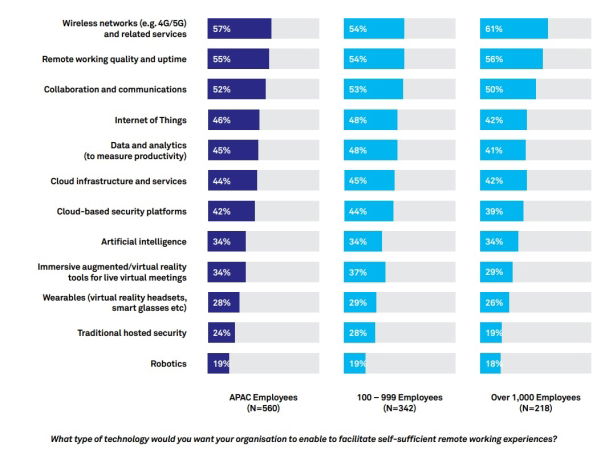share on
In Malaysia for instance, leaders are investing more in wireless networks (e.g. 4G/5G) and related services, data and analytics to measure productivity, and cloud infrastructure and services.
Businesses all over the world are finding themselves in a pivotal position today, deciding what their new work order will be like post-pandemic.
Identifying how business decision makers across APAC are rethinking operations and work arrangements to benefit both employers and employees in the hybrid work era, telecommunications service provider Telstra examines four key areas to help businesses bounce back from the pandemic: collaboration, leadership, productivity and economic impact, and optimised hybrid work and technology.
With insights from more than 450 business decision makers and 560 employees across Asia, including Australia, India, Indonesia, Malaysia, Philippines, Singapore, Thailand, and Vietnam, the Telstra Asia Pacific Transformation Vision: Optimising for Hybrid research found that 21% of organisations surveyed have put expansion plans on hold owing to uncertainty around the pandemic. Despite so, expansions still remain high on companies’ operations growth plans, with 38% looking to expand globally, and 28% looking at APAC markets.
With the disruption brought about by the pandemic, businesses have had to adapt to the new work order – 85% of organisations in the region are promoting hybrid work arrangements, and seven in 10 are now recruiting talent from all locations and allowing hybrid work arrangements. In that vein, organisations surveyed are expecting virtual work to increase by 83% in the next six to 12 months, despite offices reopening. In addition, 74% of employees in APAC believe that they and their teams are more productive with flexible work arrangements.
As for strategic technology transformation priorities for their organisations, businesses were observed to be scaling up their investments in emerging technologies and cybersecurity. Particularly, APAC business leaders have identified three areas for investment: emerging technologies (45%), cybersecurity (43%), and digital innovation projects (41%). Large and small businesses differ in their focus priorities.
While large companies are focused on improving agile processes, including the way they work with partners such as service and solutions providers, smaller organisations are prioritising cybersecurity improvements.

The study further looked into the impact of collaborative technology on employee engagement and cultural exchange.
In terms of how technology is facilitating successful hybrid work environments, three out of four employees say that it has become easier to stay engaged and drive cultural exchange with technology.

From organisations' perspective, 70% of organisations already have a strategy in place to identify and deploy the right technology and tools to facilitate both office-based and remote work.
Looking specifically into tools to enable optimised hybrid working from an employee perspective, the number one tool that would facilitate selfsufficient remote working is wireless networks and other related services. Quality and uptime of remote working services were equally important, especially among smaller organisations, as it could impact employee productivity and communication.
Interestingly, 37% of employees in small organisations show more of an affinity towards immersive digital experiences, like augmented reality and virtual meeting platforms, than those in larger organisations.

Overall, the five tools for a self-sufficient remote workforce were:
- Wireless networks (e.g. 4G/5G) and related services
- Remote working quality and uptime
- Collaboration and communication
- Internet of things
- Data and analytics to measure productivity
Particularly for HR to note, there is a clear need for policies and guidelines to cover remote work scenarios as both business leaders and employees embrace hybrid-working experiences. In many large organisations especially (72%), the role of HR has already started to expand with full hybrid policies and guidelines in place, ranging from recruitment processes to compensation standards.

The above aside, the study also noted the top three ICT spend by market.
Malaysia
- Wireless networks (e.g. 4G/5G) and related services
- Data and analytics to measure productivity
- Cloud infrastructure and services
Singapore
- Data and analytics to measure productivity
- Cloud infrastructure and services
- Internet of Things
Indonesia
- Application and data
- Wireless networks (e.g. 4G/5G) and related services
- Cloud infrastructure and services
- Internet of Things
Thailand
- Wireless networks (e.g. 4G/5G) and related services
- Remote working quality and uptime
- Cloud-based security platforms
Vietnam
- Application and data
- Traditional hosted security
- Data and analytics to measure productivity
India
- Cloud-based security platforms
- Wireless networks (e.g. 4G/5G) and related services
- Cloud infrastructure and services
The Philippines
- Data and analytics to measure productivity
- Wireless networks (e.g. 4G/5G) and related services
- Application and data
Photo / Telstra Asia Pacific Transformation Vision: Optimising for Hybrid
share on


